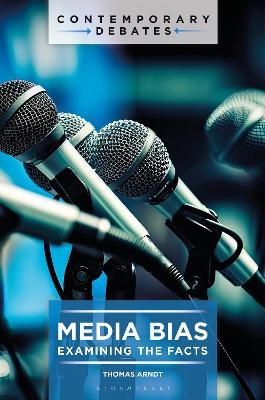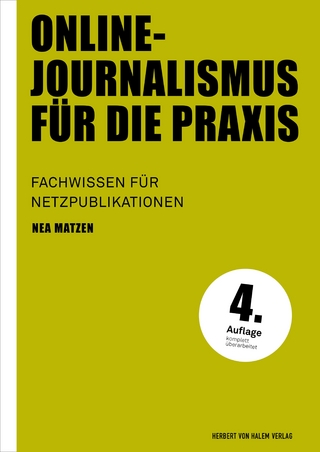
Media Bias
Bloomsbury Academic (Verlag)
978-1-4408-8035-3 (ISBN)
- Noch nicht erschienen (ca. Mai 2025)
- Versandkostenfrei
- Auch auf Rechnung
- Artikel merken
The book provides students and other readers with a clear and accurate understanding of claims of media bias (both conservative and liberal) in the United States by refuting falsehoods, misunderstandings, and exaggerations surrounding this topic – and confirming the validity of other assertions. In addition, this sourcebook examines claims and assertions about media bias in other realms of American life, from popular entertainment to social media platforms.
Media Bias: Examining the Facts has been specifically crafted to give readers the tools for a fuller and more accurate understanding of the facts surrounding controversial issues, policies, and laws that occupy center stage in American life and politics. Specific areas of focus in this volume include defining and understanding conscious and unconscious bias; the evolution of the news industry and partisan news sources in the digital age; the ways in which political polarization exacerbates media bias, laws and practices that govern the operations of news media; and clear examples of conservative and liberal bias in such media sectors as cable and broadcast news, radio, newspapers and magazines, talk radio, and online platforms.
Thomas Arndt is Adjunct Professor in the Department of Political Science at The College of New Jersey, USA. He is author of America's National Debt: Examining the Facts (ABC-CLIO, 2022).
How to Use This Book
1. The Nature of Bias
Q1. What does it mean to be biased?
Q2. How prevalent is political bias in major media outlets?
Q3. Is bias always a bad thing for consumers of news and information?
Q4. Why have many media outlets seemed to grow increasingly biased over recent years?
Q5. What is a so-called bias of omission?
Q6. When is there a difference between bias and things like disinformation or propaganda?
Q7. Is there any way to measure the accuracy or fairness of news?
2. Mass Media, Politics, and Culture
Q8. How did the development of mass media impact American politics?
Q9. How did the development of the so-called adversarial press shape perceptions of bias?
Q10. How did the corporatization of media change the ways in which news and information are disseminated?
Q11. Is media bias responsible for today’s extreme political polarization?
Q12. Are there differing levels of bias in different types of media (print, TV, online)?
3. Opinions and Editorialization
Q13. What is the importance of op-ed pieces in newspaper outlets?
Q14. How important is it when media outlets endorse partisan candidates running for office?
Q15. How carefully do media outlets distinguish between facts and opinions in their content?
Q16. Who decides which news events and stories receive the most attention?
Q17. What is fake news?
4. Liberal Bias
Q18. Is the frequent conservative charge of liberal media bias in mainstream news accurate?
Q19. How biased are cable news stations like CNN and MSNBC or newspapers like the New York Times or Washington Post?
Q20. How have liberal conspiracy theories tainted the presentation of news?
Q21. Is there liberal bias built into the algorithms used by giant tech firms like Facebook, Twitter, and Google?
5. Conservative Bias
Q22. What explains the dominance of Fox News Channel on cable TV?
Q23. How biased are newspapers like the Wall Street Journal or New York Post?
Q24. How have conservative conspiracy theories tainted the presentation of news?
Q25. How influential have far-right or alt-right media outlets been vis-à-vis talk radio, podcasts, and various online forums?
6. Governance, Regulations, and Reforms
Q26. Why do some countries have a state-run media?
Q27. What is the job of the FCC when it comes to content moderation or censorship?
Q28. What is the so-called Fairness Doctrine?
Q29. What is the rationale behind calling for the social media giants to be regulated and/or broken up?
Q30. How does Section 230 offer protections for media companies and how has it shaped political bias on the internet?
Q31. What can consumers of news do to help foster competent and balanced presentations of news in the future?
Index
| Erscheint lt. Verlag | 1.5.2025 |
|---|---|
| Reihe/Serie | Contemporary Debates |
| Verlagsort | London |
| Sprache | englisch |
| Maße | 156 x 235 mm |
| Themenwelt | Sozialwissenschaften ► Kommunikation / Medien ► Journalistik |
| Sozialwissenschaften ► Politik / Verwaltung ► Politische Systeme | |
| Sozialwissenschaften ► Politik / Verwaltung ► Politische Theorie | |
| Sozialwissenschaften ► Politik / Verwaltung ► Staat / Verwaltung | |
| ISBN-10 | 1-4408-8035-2 / 1440880352 |
| ISBN-13 | 978-1-4408-8035-3 / 9781440880353 |
| Zustand | Neuware |
| Informationen gemäß Produktsicherheitsverordnung (GPSR) | |
| Haben Sie eine Frage zum Produkt? |
aus dem Bereich


